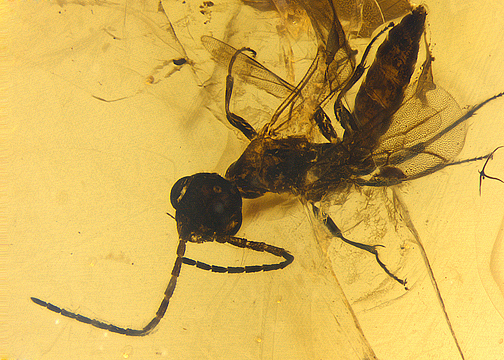Abstract
Information provided by eight specimens of Plumalexius ohmkuhnlei Rasnitsyn & Brothers, 2020 has enabled significant amplification of our knowledge of the characteristics of the genus Plumalexius as a whole. Analysis of a matrix including this additional information has confirmed and strengthened the conclusions of Brothers’s ten-year old paper describing the family Plumalexiidae, and the genus and species Plumalexius rasnitsyni Brothers, 2011, and evaluating the phylogeny of the Chrysidoidea based on morphology.
References
Branstetter, M.G., Danforth, B.N., Pitts, J.P., Faircloth, B.C., Ward, P.S., Buffington, M.L., Gates, M.W., Kula, R.R. & Brady, S.G. (2017) Phylogenomic insights into the evolution of stinging wasps and the origins of ants and bees. Current Biology, 27, 1019–1025. https://doi.org/10.1016/j.cub.2017.03.027
Brothers, D.J. (1975) Phylogeny and classification of the aculeate Hymenoptera, with special reference to Mutillidae. The University of Kansas Science Bulletin, 50 (11), 483–648.
Brothers, D.J. (2011) A new Late Cretaceous family of Hymenoptera, and phylogeny of the Plumariidae and Chrysidoidea (Aculeata). ZooKeys, 130, 515–542. https://doi.org/10.3897/zookeys.130.1591
Brothers, D.J. (2019) Aculeate Hymenoptera: phylogeny and classification. In: Starr, C. (Ed.), Encyclopedia of social insects. Springer, Cham. pp. 1–9. https://doi.org/10.1007/978-3-319-90306-4_1-1
Clarke, D.J., Limaye, A., McKenna, D.D. & Oberprieler, R.G. (2018) The weevil fauna preserved in Burmese amber—snapshot of a unique, extinct lineage (Coleoptera: Curculionoidea). Diversity, 11, 1. https://doi.org/10.3390/d11010001
Goloboff, P.A. & Catalano, S.A. (2016) TNT version 1.5, including a full implementation of phylogenetic morphometrics. Cladistics, 32, 221–238. https://doi.org/10.1111/cla.12160
Goloboff, P.A., Farris, J.S. & Nixon, K.C. (2020) Tree Analysis Using New Technology (TNT), Version 1.5. Available from: http://www.lillo.org.ar/phylogeny/tnt/ (accessed March 2020)
Lucena, D.A.A. & Almeida, E.A.B. (2021) Morphology and Bayesian tip-dating recover deep Cretaceous-age divergences among major chrysidid lineages (Hymenoptera: Chrysididae). Zoological Journal of the Linnean Society, 44 pp. https://doi.org/10.1093/zoolinnean/zlab010
Melo, G.A.R. & Lucena, D.A.A. (2019) Chrysobythidae, a new family of chrysidoid wasps from Cretaceous Burmese amber (Hymenoptera, Aculeata). Historical Biology, 32 (8), 1143–1155. https://doi.org/10.1080/08912963.2019.1570184
Nixon, K.C. (2002) WinClada ver. 1.00.08. Published by the author, Ithaca, NY. Available from: cladistics.com/aboutWinc.htm (accessed 2010) Replacement now available from [http://www.diversityoflife.org/winclada/]
Rasnitsyn, A.P. & Brothers, D.J. (2020) The first plumalexiid wasp (Hymenoptera: Chrysidoidea, Plumalexiidae) from the mid-Cretaceous Burmese amber. Cretaceous Research, 115 (104568), 1–5. https://doi.org/10.1016/j.cretres.2020.104568
Xing, L. & Qiu, L. (2020) Zircon U–Pb age constraints on the mid-Cretaceous Hkamti amber biota in northern Myanmar. Palaeogeography, Palaeoclimatology, Palaeoecology, 558, 109960. https://doi.org/10.1016/j.palaeo.2020.109960


